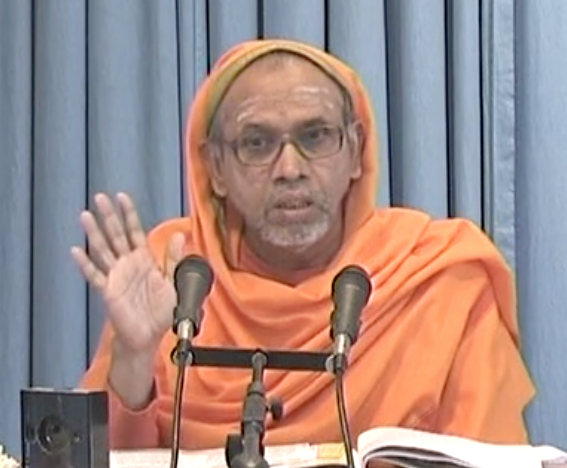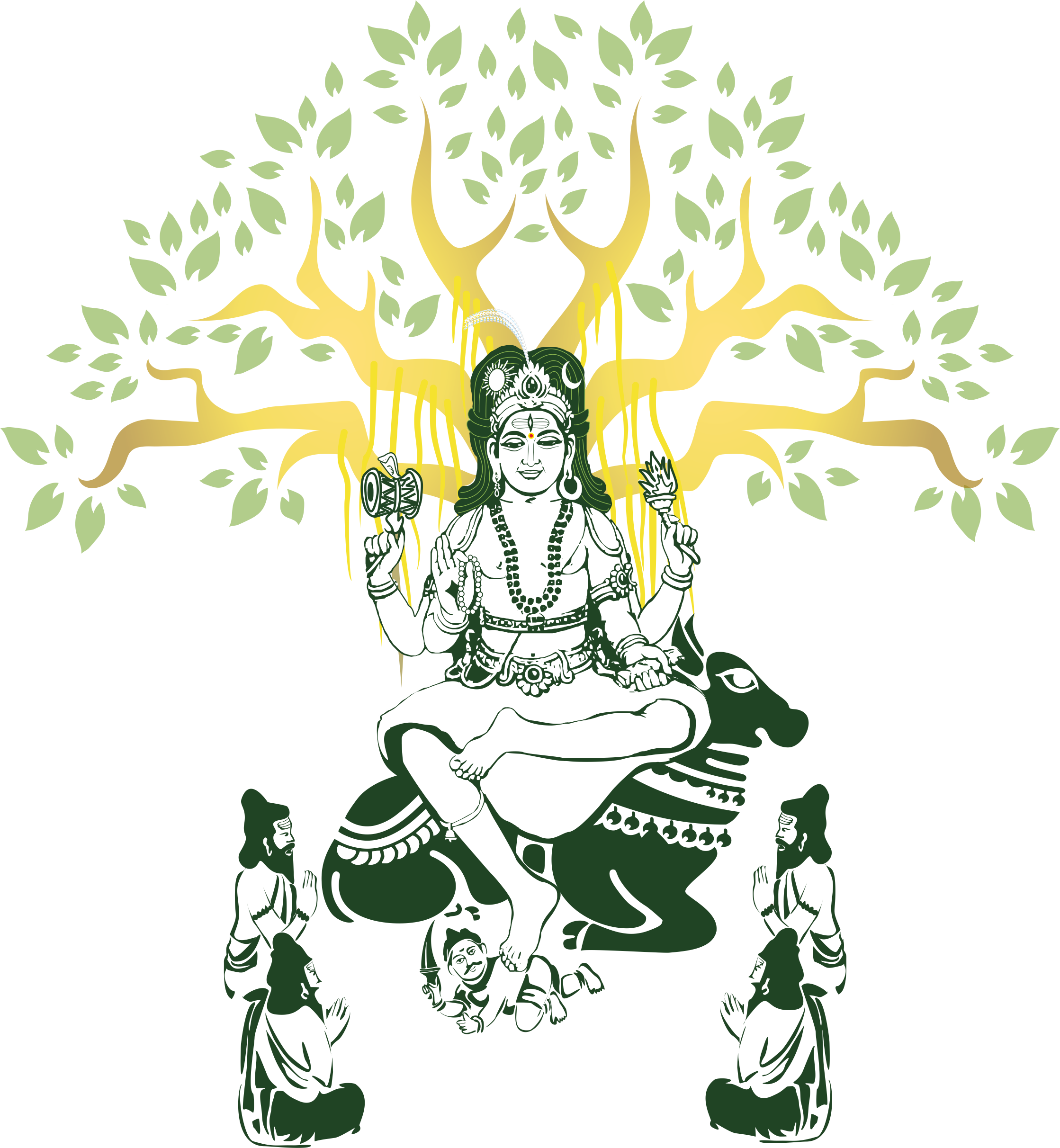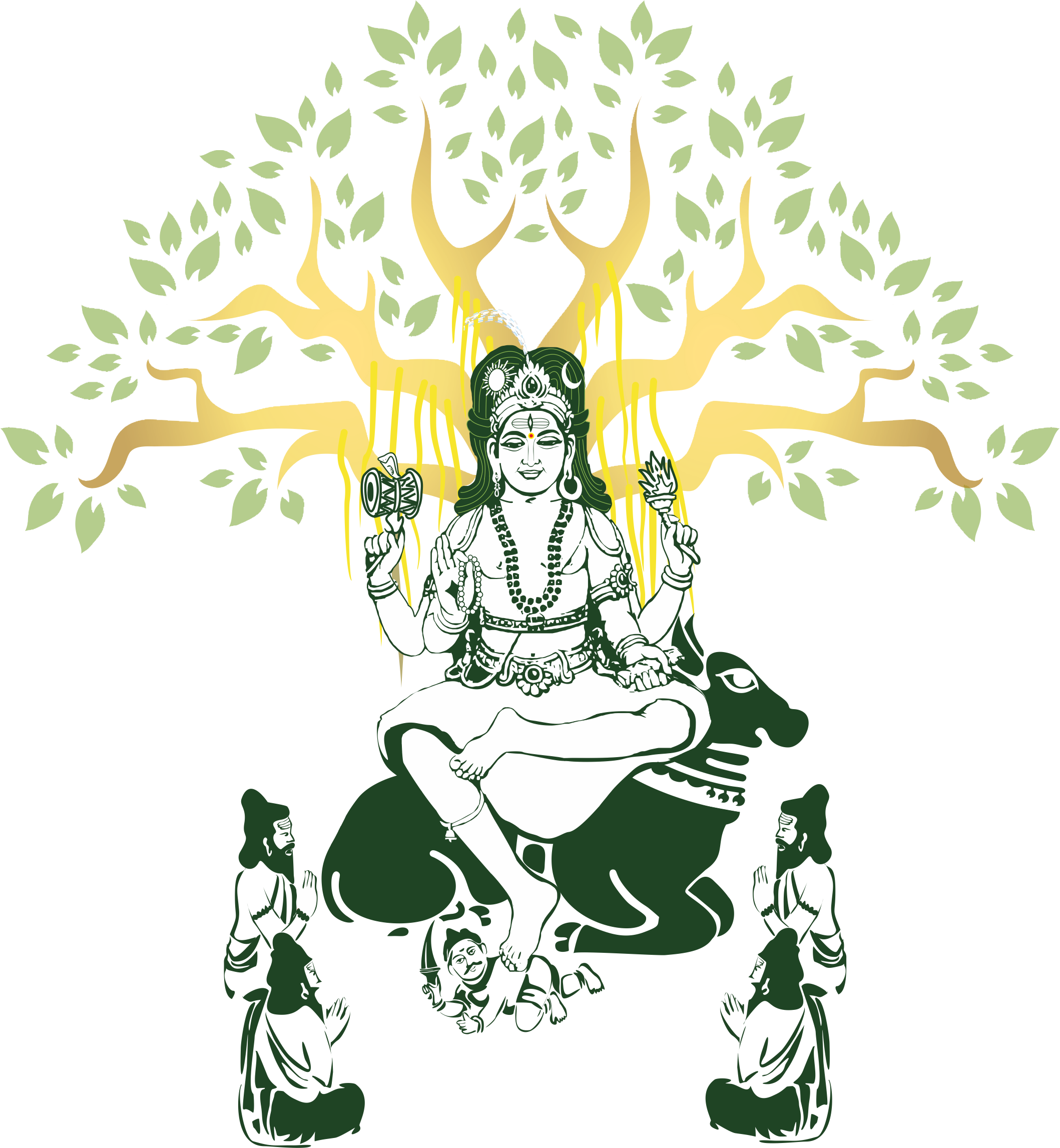Namaste Gaṇapataye
By Swami Tattvavidananda
Published in Arsha Vidya Gurukulam 33rd Anniversary Souvenir

Namaste Gaṇapataye – to you, Lord Gaṇapati, I prostrate and pay my obeisance.
Gaṇapataye namaḥ – The word namaḥ has a very interesting etymology. Literally, it indicates the prahvī-bhāva. This assumes that you have another person, an altar, or a mūrti in front of you, which amounts to saying that īśvara is present there. Before one such, you would bow your head in respect. This is called the prahvī-bhāva. Prahva literally means bowing one’s head. Therefore, here the word namaḥ means “I bow my head before you” and is a symbol of humility.
Namaḥ has another interesting etymology: na me iti namaḥ. The
phrase na me translates as ‘not mine.’ As a person takes birth in this world,
he assumes a few things to be his own. When he is born, he starts life with a
physical body. Even though strictly speaking the mother gives this physical body
to him, we can make an allowance for him owning it. Therefore, while he cannot
claim ownership of even the clothing he wears upon that body, he can say that
the body is his. Every other consideration comes later and it comes to him by
the grace of īśvara.
This grace appears in the form of the pañcabhūtas, the five elements.
So whatever we have, whether they are inanimate material objects or
relationships such as that of a son, daughter, mother, or father, they are
given to us by īśvara and all of them are manifestations of the pañcabhūtas.
For example, take a rock and a tree. One is a living form and the other is
inanimate. Even though the difference is seen and experienced, both are nothing
but the pañcabhūtas. In a particular configuration, these pañcabhūtas result in
the formation of a rock, and when assembled in a different configuration, they
have the ability to form an organism and reflect life. This applies to a human
being also. The body that you consider to be you and yours is just another configuration
of the pañcabhūtas. Even these pañcabhūtas have been given to us, in the sense
that they do not belong to anyone nor were they created by anyone.
In this universe, ignorance alone makes it possible to imagine
that a few things belong to me. In knowledge, these notions have no meaning. It
is this understanding that is reflected in saying na me or namaḥ. It is a way
of presenting this understanding before the Lord, as though saying, “Hey parameśvara,
in my existence, it is out of ignorance that I assume my body to be me and a
few possessions to be mine. Everything is really yours, nothing is mine.” In
the context of this Upaniṣad, both meanings may be taken together: namely, that
we emerge from the sense of ‘me and mine’ and that we assume humility before
the altar of the Lord. This therefore is the meaning of namaḥ.
The Lord’s name here is Gaṇapati, and the devotee addresses Gaṇapati
as te gaṇapataye – unto you, Lord Gaṇapati, my namaskāra. The word ‘gaṇapataye’
is the fourth vibhakti, declension. Grammatically, the word ‘te’ can be in
either the fourth or the sixth declension. But the context here determines that
‘te’ means tubhyam (‘unto you’) and not tava (‘yours’). So this line translates
as “unto you, Lord Gaṇapati, I prostrate and pay my obeisance.”
The meaning of Gaṇapati
Let us examine who Gaṇapati is. We can look at Gaṇapati in
two ways. One way is the theological or story aspect. We have to take into
account that every altar is associated with a story. This is because you can
relate to the same īśvara either as nirguṇa-nirākāra (without attribute or
form) or as saguṇa-sākāra (with attributes and form). Upāsanā, meditation, on
saguṇa-sākāra is easy. A devotee’s life begins with an upāsanā in his
assumption that he is a limited individual and has to relate to the
all-powerful arameśvara. The saguṇa-sākāra aspect arises from this point of
view.
In the Gītā, Bhagavān says mamaivāmśo jīvaloke jīvabhūtasanātanaḥ1
– you take yourself to be a jīva, a limited individual, and while you see
yourself as being this limited individual, you must also understand that you
are never separate from the whole. It is this pūrṇa-tattvam, the whole or the
total entity, with which one must establish a connection. Based on this we have
the upāsanā in which the altar is the saguṇa-sākāra. By definition, the saguṇa-sākāra
implies infinite guṇas and infinite ākāras.
When faced with the numerous forms of the Lord, it becomes difficult
to relate to any one of them. That is why the Vedic sages have presented a few
forms before us, depending upon the disposition of the person. One of these
forms is Gaṇapati. When we have an ākāra, a set of attributes or guṇas goes
with it and there is also a set of stories around it. The purpose of the
stories is not so much to establish historicity as to buttress the guṇas that
are attributed to the ākāra. We relate a purāṇic story about Gaṇapati. Then you
have Śiva, the pūrṇa-tattvam-parabrahma. It may be Śiva in a particular context
or Viṣṇu in a different context. Śiva as maṅgala-svarūpa is all auspiciousness.
Just as the power of a person is associated with him in an inseparable way, Śiva
is associated with a śakti. Now we have śiva-śakti.
And then there is the jīva. Unlike in the case of pūrṇam, where
there is only one pūrṇam, if you say jīva, you mean an infinite number of
jīvas. Some of these jīvas are exalted and some of them may be at a lower
status or stratum as it were. Some of these exalted jīvas are very close to
īśvara by virtue of their bhakti and knowledge. All the exalted jīvas that are
close to īśvara together constitute one entity or group called a gaṇa.
There is beautiful symbolism here. From the unique perspective
of the universe that obtains here, no jīva is an island. You can have real
happiness only when you dilute your personality and individuality, and
surrender it at the altar of the whole. That is why all living beings exist and
thrive in groups, each of these groups being a gaṇa. This gaṇa group psychology
applies to devatās. These gaṇas exist in one final supreme reality, which is
īśvara. Īśvara is the overlord of all these gaṇas of life forms. That is why he
is called the gaṇapati. This is the meaning of the mantra “gaṇānāṁ tvā gaṇapatim
havāmahe.”
Because the compound word gaṇānām can mean many things, such
as gaṇasya patiḥ (Lord of one gaṇa) or gaṇayoḥ patiḥ (Lord of two gaṇas), or gaṇānām
patiḥ (Lord of innumerable gaṇas), the mantra says that he is the ‘gaṇānām patiḥ,’
or Gaṇapati.
Thus, we have here namaste Gaṇapataye. You can look at it as
saguṇa-sākāra, i.e., Ganeśa Maharāj, the son of Śiva. The other way would be to
look at it as meaning that all the life forms in this universe come into the
world as groups, live as groups, and resolve as groups; the source of all these
three processes is īśvara; and here he is in the form of Gaṇapati.
Tvameva pratyakṣam
tattvamasi
Tattvam means reality. What appears to be real may not be real.
In fact, we define reality as “an existence that is not affected or influenced
by time.” For instance, consider a ghaṭa, pot. We don’t call the pot reality
because it did not exist before a particular given time, and after a while it
may not be there. Even an antique pot will disappear: it comes to exist in
time, and after a while it ceases to exist. We don’t call such a thing real.
Reality is trikāla-abādhitam-satyam, something that is not negated in the three
periods of time: bhūta, bhaviṣya, and vartamāna (past, present, and future). Such
a thing alone is reality.
Addressing Gaṇapati, the teacher says that this changeless reality,
this immutable truth is you, tvameva pratyakṣam tattvamasi. The tattvam is
pratyakṣam, directly understood. You are the reality, which expresses itself
through the eyes, ears, etc. as śrotasya śrotraṁ cakṣuśaścakṣuḥ, the ear of the
ear, the eye of the eye. That is the pratyakṣam. The word is grammatically
derived as akṣam prati pratyakṣam, that which is directly seen. Eyesight is
caitanyam, consciousness, which has acquired a particular expression. When I
see a fruit and I understand it as fruit, this is ‘fruit knowledge’ expressing
itself. This is the awareness in which the fruit appears. When this awareness
is expressed through a certain upādhi, conditioning adjunct, it becomes the
knowledge of fruit. The fruit happens to be the nāma-rūpa, the upādhi through
which that knowledge is expressing. It is like a necklace of gold, which is
gold expressing as a necklace. When reflecting in a different form, the same
gold is called something else. It is the same with pot knowledge, book knowledge,
etc. All these ‘knowledges,’ as it were, appear to be different but they are
not. While there is a difference in them, there is also a commonality. The
factor which makes them differ from each other is unreal – the nāma-rūpa.
The commonality in all these knowledges is real, and that is
the tattvam. In the tattvam vision, there is no scope for rāga-dveṣa because
tattvam is anāropitākāram, free of any superimpositions. There is scope for
rāga-dveṣa only in the nāma-rūpa vision. For example, when you talk of a shirt,
the question of liking or disliking it arises, but when you talk of fabric or
cloth, there is no question of like or dislike. Fabric doesn’t evoke the
response of like or dislike in you in the same manner that it does when it is
in a particular form. That is why the Vedantic attempt is to divert the
attention of a person away from the nāma-rūpa and towards the tattvam. The tattvam
alone is real. The nāma-rūpa is always unreal. Therefore, we have here,
tvameva pratyakṣam
tattvam asi. tvameva kevalam kartāsi – tvameva kevalam dhartāsi – tvameva
kevalam hartāsi
Here there are three things: kartā, dhartā, and hartā. There
are many phenomena that occur each day, but at the universal level they are
only three. Any discussion of īśvara centers upon these three universal actions
or phenomena, which are sṛṣṭi, sthiti, and pralaya (creation, sustenance, resolution).
Sṛṣṭi arises from ‘you’, sthiti is in ‘you,’ and pralaya happens into ‘you.’
Kevalam means that ‘you alone’ are the one source. We may ask if there are
three entities, each with a responsibility, but the difference is only verbal
because here Gaṇeśa is the only tattvam. This is not to be interpreted to mean
that Gaṇeśa and not Brahmāji is the creator. It means that there is one reality
responsible for creation, and the universe abides in him and resolves in him.
You may call this reality Śiva or Viṣṇu or Rudra, but in this present context
we are calling it Gaṇeśa Maharāj or Gaṇapati.
tvameva sarvaṁ
khalvidaṁ brahmāsi
Space and time originate from īśvara and he transcends both
in being niratiśayam bṛhat, or bigger than space. So brahman means ‘subtler
than space.’ The universe is understood as a plurality, while in reality it is
not so. In the context of a space and time framework alone, as experienced by
the sense organs, this plurality is a ‘perceived’ division. Īśvara is the reality
in which this universe has its existence. There are several ways of
understanding īśvara. One could perceive this universe before us, in all its
apparent plurality and diversity, as nothing but a collection of the pañcabhūtas,
some reflecting life, others being inanimate. These pañcabhūtas exist in a
tapered manner. In their grossest form, they are prithvī and in their subtlest
form, they are ākāśa. In between, we have all the varying degrees of
manifestation. Everything that exists can be broken down into its component
pañcabhūtas, with one or the other of the pañcabhūtas being more or less
predominant in its existence, giving it its own characteristic form or feature.
In perceiving all existence thus, we understand both the limited ‘is-ness’ and
its opposite, ‘is not-ness,’ to have their existence in īśvara. This way of
arriving at īśvara called the sat model.
The other is the cit model. Just as there is a world outside
in which I see īśvara, there is a world inside me also. First, there is this
body, which has its existence in the sense organs because without them there is
no body. These senses have their existence in the mind. This in turn exists in
the buddhi. This buddhi exists in the aham, the ego, and the aham exists in the
ātma-caitanyam. All the limitations of the aham are superimposed on the ātmā.
The aham is the awareness. For instance, we know of the atom
and how subtle it is. But the mind through which we know it has to be subtler
than the atom because in the knowing, the atom becomes an object of the mind.
This is quite like saying that the mind that made the computer possible is
superior to the computer. The ātmā is superior to this mind because the mind is
like a wave that comes up in the ātma-caitanyam and goes back into it. The ego
belongs to the mind, and there is no ego without the ātmā. So in away, the ego
is the child of the ātmā even though the ego overshadows the ātmā. With the
birth of the ego, this ātma-caitanyam is as though lost sight of and the ego
becomes all. When I understand this truth, the ego diminishes. As the ego
becomes smaller, the ātma-caitanyam comes into focus better, and finally, when
the ego is resolved, there is only ātmā. Because the ego identifies itself with
the physical body, it is subject to the limitations of time and space. The limitations
of time and space do not exist in this ātmā, and therefore ātmā is indeed
saccidānanda brahman.
This realization arrived at through the path that highlights
the sat aspect of reality is called brahman, and arrived at through the other
path, where the cit aspect of reality is highlighted, it is called ātmā. They
are one and the same. Taking both these approaches into account, the śruti
says, tvameva sarvaṁ khalvidaṁ brahmāsi.
tvam sākṣādātmāsi
nityam
Sākṣāt is an important word. There are a few categories: one
is pratyakṣa, something that is understood through perception. Another is parokṣa,
meaning that it is akṣa-para, not available to the eye. Heaven, for example,
would be parokṣa.
The mind is not available for perception in the same manner as
a fruit is, even though it is through the mind that we perceive the fruit. The
objects of the world are known to this ego. The ego identifies with the mind,
and as the mind, the fruit is pratyakṣa. That is why the world is called
ābhāsa-bhāsya, that which is lit up or made visible by ābhāsa, which is the ego
identified with the mind. This ābhāsa is the seer, hearer, taster, etc. The
moods of the mind are not ābhāsa-bhāsya, however. They are the states of the
mind, and the mind is not available to itself. Although the mind is not
available for perception, the individual who is the witness (sākṣī) knows and
is aware of the states of the mind. We do know our minds, and so the states of
the mind are called sākṣi-bhāsya. Thus, there is sākṣi-bhāsya and ābhāsa-bhāsya.
The ‘pot’ is ābhāsa-bhāsya and sukha is sākṣi-bhāsya. This sākṣi-bhāsya is
called aparokṣa.
Therefore ābhāsa-bhāsya is either pratyakṣa – as in phala, a
fruit – or aparokṣa – as in svarga, heaven. The states of mind like sukha, duḥkha,
cañcala-manaḥ, or ekāgra-manaḥ are called aparokṣa.
This sākṣī cannot fit into any of these categories: it is
not pratyakṣa, or parokṣa, or even aparokṣa. So it is called sākṣāt-aparokṣa.
It is svayaṁ-prakāśa or svayaṁ-jñāta, self-evident. Just as one light, however,
dim or bright, glows in its own light and cannot be illuminated by another light,
the sākṣī is self-evident. This sākṣi-caitanyam is brahman. This is a mahāvākya
– yad sākṣādaparokṣat caitanyaṁ vartate, tad brahma. This is the essence of
tvam saksādātmāsi nityam.



